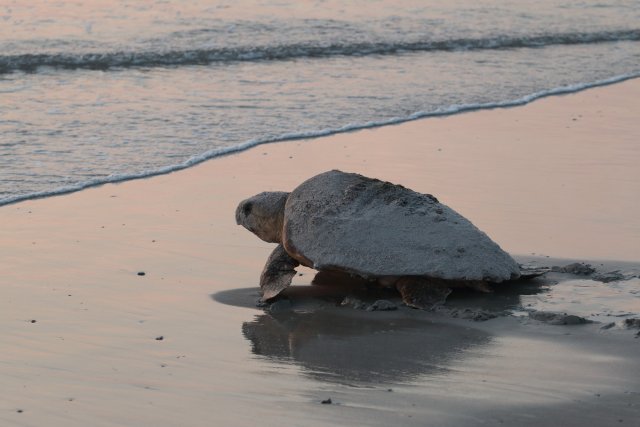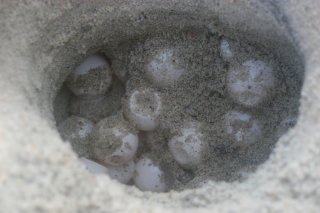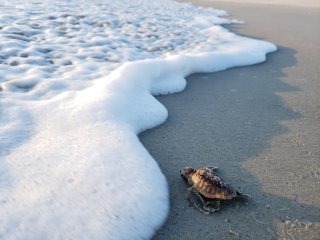Climate Change Connections: South Carolina (Loggerhead Sea Turtles)
Climate change is impacting all regions and sectors of the United States. The State and Regional Climate Change Connections resource highlights climate change connections to culturally, ecologically, or economically important features of each state and territory. The content on this page provides an illustrative example. As climate change will affect each state and territory in diverse ways, this resource only describes a small portion of these risks. For more comprehensive information about regional climate impacts, please visit the Fifth National Climate Assessment and Climate Change Impacts by Sector.
On this page:
Introduction: Sea Turtles and Coastal Ecosystems

South Carolina is known for its scenic barrier islands, which run parallel to the coast and help protect the mainland from storms.1 These islands create pristine sandy nesting areas for sea turtles. These marine reptiles nest along the Atlantic coast from May to August, laying eggs on sandy beaches between the high tide line and the dunes.2 Four species of sea turtles can be found in the coastal waters of South Carolina: loggerheads, Kemp’s ridleys, leatherbacks, and green sea turtles.3 Loggerhead sea turtles are especially iconic in South Carolina. Not only are they the official state reptile,4 they also draw visitors to the coast every summer. Tours at Myrtle Beach and elsewhere offer a chance to catch a rare glimpse of nesting loggerheads. The South Carolina Department of Natural Resources Marine Turtle Conservation Program also actively monitors nest activities along the beaches with the help of more than 1,500 individuals across the state each year.5
Loggerheads are important to marine ecosystems. The turtles provide food for predators and habitat for algae and barnacles that live on their shells. Nesting can increase nutrient levels on beaches,6 which helps support vegetation and other organisms. The loggerhead sea turtle is protected as a threatened species under the Endangered Species Act.7

Adult loggerheads can migrate hundreds to thousands of miles between their foraging grounds and nesting beaches. After mating between March and June, female turtles return to beaches in the same area where they originally hatched to lay eggs during the night.7 The eggs incubate for about two months in the sand and then hatch. Hatchling turtles make their way to the sea and grow to adulthood in the open ocean.7 Multiple threats have contributed to loggerhead population decline in recent decades. Onshore, coastal development has led to the loss of nesting habitat and light pollution can confuse baby sea turtles whose natural instincts are to head toward the moon. In the ocean, turtles can become entangled in fishing gear, be struck by vessels, and ingest marine pollution.7 Climate change is threatening this already vulnerable species and its nesting habitat.
Climate Impacts: Rising Seas and Rising Heat: A Double Threat
Warming temperatures contribute to sea level rise in two key ways. The melting of land ice (namely glaciers and ice sheets) contributes to increases in the volume of water in the ocean, and as water warms, it expands slightly. Rising sea levels can impact coasts by inundating low-lying wetlands and dry land, eroding shorelines, and contributing to coastal flooding.
Sea level rise and tidal flooding could become a major issue for South Carolina in the future. In South Carolina, sea levels have risen over the past century and are projected to continue rising, with an expected range of 1 to 4 feet by 2100.8 For loggerhead turtles, sea level rise directly impacts nesting. Rising sea levels chip away at beaches, narrowing the area where turtles can safely lay eggs. Higher sea levels increase storm surge, which damages the barrier island environment that turtles need.9 Sudden flooding from storm surge can also wash out existing nests.

With climate change, temperatures in South Carolina are projected to warm over the rest of this century and the number of extremely hot days is also expected to increase.8 Warming temperatures could have a negative effect on egg and hatchling survival. Since sea turtle eggs incubate under the sand, they are vulnerable to high sand temperatures, which can kill off embryos.2 Heat can also affect hatchling health. Research has shown that loggerhead turtle hatchlings do best when eggs are incubated at between 83°F to 88°F.10 Temperatures above about 90°F lead to lower survival rates for hatchlings.10
Temperature also determines the sex of hatchling turtles. Higher nest temperatures cause embryos to develop into females, while cooler temperatures favor males. As temperatures rise, more female hatchlings are born, creating a skewed sex ratio that could have implications for future reproduction.11 If South Carolina warms as projected, there could be too few males available to maximize reproduction, which would put the population at risk.12 It’s possible that if the maximum predicted amount of climate warming occurs (45.5°F or 7.5°C), loggerhead sea turtles in the Atlantic would produce almost all female hatchlings.13
Taking Action: Conservation in a Changing Climate
Addressing climate change requires reducing greenhouse gas emissions while preparing for and protecting against current and future climate impacts. Communities, public officials, and individuals in every part of the United States can continue to explore and implement climate adaptation and mitigation measures. In South Carolina, researchers and conservation organizations are collaborating on actions to protect turtles from rising seas and other threats, including:

- Habitat protection. The South Carolina Department of Natural Resources oversees volunteer work and nest monitoring, and raises public awareness on the importance of leaving nests undisturbed.5 The National Oceanic and Atmospheric Administration’s Fisheries division also works to protect critical turtle habitat, support recovery, and reduce bycatch (the accidental catch of sea turtles in commercial fishing equipment).14,15 Ensuring that development is set back from the shore can help protect homes and give turtles a buffer zone for nesting.16 Irrigating or shading nests could keep temperatures cool to improve hatchling and egg survival.17 Artificial shading in hatcheries is another potential method for cooling nests.18
To learn more about climate change impacts in South Carolina and the Southeast region, see Chapter 22 of the Fifth National Climate Assessment.
Related Resources
- EPA Climate Change Indicators: Sea Surface Temperature
- EPA Climate Change Indicators: Sea Level
- EPA Climate Change Indicators: A Closer Look: Land Loss Along the Atlantic Coast
- South Carolina State Climate Summary 2022 (NOAA)
- Loggerhead Turtle (NOAA)
References
1 Gorstein, M. (2021). The economic benefits of South Carolina’s beaches and barrier Islands [Technical Report]. S.C. Sea Grant Consortium. https://repository.library.noaa.gov/view/noaa/48178/noaa_48178_DS1.pdf
2 Murphy, S., & Griffin, D. (2015). Supplemental volume: Species of conservation concern: Loggerhead turtle. In South Carolina State Wildlife Action Plan. South Carolina Department of Natural Resources. https://dnr.sc.gov/swap/supplemental/reptilesandamphibians/loggerheadseaturtle2015.pdf
3 South Carolina Department of Natural Resources Marine Turtle Conservation Program. (2014). Sea turtles. Retrieved July 17, 2023, from https://www.dnr.sc.gov/marine/pub/seascience/seaturtle.html
4 SC Act 588, Senate Bill 1006, 107th Session, (1988). https://www.scstatehouse.gov/sess107_1987-1988/bills/1006.htm
5 South Carolina Department of Natural Resources Marine Turtle Conservation Program. (n.d.). Sea turtle nest monitoring system. Retrieved July 14, 2023, from http://www.seaturtle.org/nestdb/?view=2
6 Hannan, L. B., Roth, J. D., Ehrhart, L. M., & Weishampel, J. F. (2007). Dune vegetation fertilization by nesting sea turtles. Ecology, 88(4), 1053–1058. https://doi.org/10.1890/06-0629
7 NOAA Fisheries. (2022). Loggerhead turtle. Species Directory. Retrieved July 14, 2023, from https://www.fisheries.noaa.gov/species/loggerhead-turtle#overview
8 Runkle, J., Kunkel, K. E., Stevens, L. E., Frankson, R., Stewart, B. C., Sweet, W., & Rayne, S. (2022). South Carolina state climate summary 2022 (NOAA Technical Report NESDIS 150-MA). NOAA National Environmental Satellite, Data, and Information Service. https://statesummaries.ncics.org/chapter/sc/
9 Lyons, M. P., Von Holle, B., Caffrey, M. A., & Weishampel, J. F. (2020). Quantifying the impacts of future sea level rise on nesting sea turtles in the southeastern United States. Ecological Applications, 30(5). https://doi.org/10.1002/eap.2100
10 Fisher, L. R., Godfrey, M. H., & Owens, D. W. (2014). Incubation temperature effects on hatchling performance in the loggerhead sea turtle (Caretta caretta). PLOS ONE, 9(12), e114880. https://doi.org/10.1371/journal.pone.0114880
11 Reneker, J. L., & Kamel, S. J. (2016). Climate change increases the production of female hatchlings at a northern sea turtle rookery. Ecology, 97(12), 3257–3264. https://doi.org/10.1002/ecy.1603
12 Hays, G. C., Laloë, J.-O., Lee, P. L. M., & Schofield, G. (2023). Evidence of adult male scarcity associated with female-skewed offspring sex ratios in sea turtles. Current Biology, 33(1), R14–R15. https://doi.org/10.1016/j.cub.2022.11.035
13 Hawkes, L. A., Broderick, A. C., Godfrey, M. H., & Godley, B. J. (2007). Investigating the potential impacts of climate change on a marine turtle population. Global Change Biology, 13(5), 923–932. https://doi.org/10.1111/j.1365-2486.2007.01320.x
14 NOAA Fisheries. (2021). Critical habitat for loggerhead sea turtle. Protected Resources Regulations and Actions. Retrieved July 17, 2023, from https://www.fisheries.noaa.gov/action/critical-habitat-loggerhead-sea-turtle
15 NOAA National Marine Fisheries Service & U.S. Fish and Wildlife Service. (2008). Recovery plan for the northwest Atlantic population of the loggerhead sea turtle (Caretta caretta). https://repository.library.noaa.gov/view/noaa/3720
16 Fish, M. R., Côté, I. M., Horrocks, J. A., Mulligan, B., Watkinson, A. R., & Jones, A. P. (2008). Construction setback regulations and sea-level rise: Mitigating sea turtle nesting beach loss. Ocean & Coastal Management, 51(4), 330–341. https://doi.org/10.1016/j.ocecoaman.2007.09.002
17 Jourdan, J., & Fuentes, M. M. P. B. (2015). Effectiveness of strategies at reducing sand temperature to mitigate potential impacts from changes in environmental temperature on sea turtle reproductive output. Mitigation and Adaptation Strategies for Global Change, 20, 121–133. https://doi.org/10.1007/s11027-013-9482-y
18 Patino-Martinez, J., Marco, A., Quiñones, L., & Hawkes, L. (2012). A potential tool to mitigate the impacts of climate change to the Caribbean leatherback sea turtle. Global Change Biology, 18(2), 401–411. https://doi.org/10.1111/j.1365-2486.2011.02532.x

